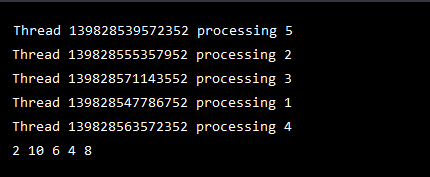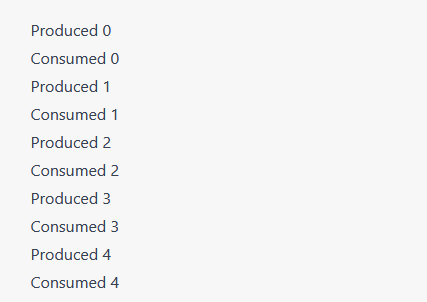C++ ConcurrencyC++ is a powerful and versatile programming language. It supports a wide range of programming paradigms, including concurrency. Concurrency is the ability to execute multiple threads of execution simultaneously in a program. It results in improved performance and responsiveness, especially in applications that involve I/O-bound or CPU-bound tasks. C++ provides built-in features and libraries for concurrency programming, such as threads, mutexes, condition variables, and futures. 1. ThreadsIt is a sequence of instructions that can be executed independently of the main program. In C++, the thread can be created using the std::thread class from the standard library. Let's understand this by the below example. Example 1:Output: 
Explanation In this example, a new thread is created by passing the" hello" function as a parameter to the std::thread constructor. Then The join() method is called on the thread object to wait for the thread to finish before exiting the program. 2. MutexesA mutex is a synchronization object that can be used to protect shared resources from concurrent access by multiple threads. In C++, a mutex can be created using the help of std::mutex class from the standard library. Let's understand this by the below example. Example 2:Output: 
Explanation In this example, a mutex is created using the help of std::mutex class. The lock() method is called on the mutex object before accessing the shared resource (in this case, the standard output stream). Then The unlock() method is called to release the mutex after the shared resource has been accessed. 3. Condition VariablesA condition variable is a synchronization object that blocks a thread until a particular condition is satisfied. In C++, a condition variable can be created using the help of std::condition_variable class from the standard library. Let's understand this by the below example. Example 3:Output: 
Explanation: In this example, a condition variable is created using the std::condition_variable class. The wait() method is called on the condition variable to block the thread until it is notified by another thread. Then The notify_one() method is called to inform the waiting thread that the condition has been satisfied. The std::unique_lock<std::mutex> is used to lock and unlock the mutex object automatically. 4. FuturesIt is a synchronization object that can be used to retrieve a value from a thread or function that is executing asynchronously. In C++, a future can be created using the help of std::future class from the standard library. Let's understand this by the below example. Example 4:Output: 
Explanation In this example, a future is created using the help of the std::future class. The std::async() function is called to launch a new thread and execute the hello function asynchronously. Then The get() method is called on the future object to retrieve the return value of the hello function. 5. MultithreadingIt is the ability to execute multiple code threads within a single application. Threads are independent paths of execution that can run concurrently with each other. It is helpful for applications that require parallelisms, such as video encoding, scientific simulations, or graphics rendering. In C++, multithreading can be achieved through the help of the Standard Template Library (STL) thread class. Example of Multithreading:Output: 
Explanation In the above example, two threads are created using the help of std::thread class to execute the foo function concurrently. Before exiting the program, The join() method is called on both threads to wait for them to finish. 6. Parallelism:It is the ability to execute multiple tasks simultaneously using multiple threads or processes. Parallelism is helpful for applications that require high performance and efficiency, such as data processing, scientific simulations, or machine learning. In C++, parallelism can be achieved using the Parallel STL library or OpenMP. Example of Parallelism:Output: 
Explanation: In the above example, the std::for_each algorithm is used to apply a lambda function to each element of a vector in Parallel using the std::execution::par policy. The lambda function simply prints the current thread ID and processes the element by doubling its value. 7. Synchronization:It is the process of coordinating access to shared resources, such as memory or files, between multiple threads or processes. It is important to ensure that concurrent access to shared resources does not result in race conditions or other errors. In C++, synchronization can be achieved using mutexes, condition variables, or atomic operations. Example of Synchronization:Output: 
Explanation In the above example, a mutex is used to synchronize access to the std::cout object, which is a shared resource between two threads executing the foo function. With The help of lock() and unlock() methods, we can acquire and release the mutex. 8. Concurrency Patterns:Concurrency patterns are common design patterns used in concurrent programming to solve common problems, such as synchronization, communication, and resource management. in C++, Examples of concurrency patterns include the producer-consumer pattern, the reader-writer pattern, and the monitor pattern. Example of Concurrency Pattern:Output: 
Explanation In the above example, a simple producer-consumer pattern is implemented using a mutex, a condition variable, and a shared queue. The `producer` function generates five integer values and pushes them onto the queue with a delay of 500 milliseconds between each push. After each push, it notifies the waiting consumer thread using the `notify_one()` method. The `consumer` function waits for notifications from the producer thread using the `wait()` method of the condition variable. It consumes the values from the queue with a delay of 1000 milliseconds between each consumption. Best PracticesWhen working with concurrency in C++, it is essential to follow best practices to ensure the reliability and efficiency of your application. Best practices include avoiding the shared mutable state, using thread-safe data structures, minimizing the use of locks and synchronization, and testing your code thoroughly. ConclusionC++ provides a wide range of features and libraries for concurrency programming, such as threads, mutexes, condition variables, and futures. These features can be used to improve the performance and responsiveness of applications that involve I/O-bound or CPU-bound tasks. It is important to use these features correctly and safely, as concurrency programming can be complex and error-prone. With careful design and testing, however, C++ can be a powerful tool for concurrent programming.
Next TopicWhat are Macros in C++
|
 For Videos Join Our Youtube Channel: Join Now
For Videos Join Our Youtube Channel: Join Now
Feedback
- Send your Feedback to [email protected]
Help Others, Please Share










